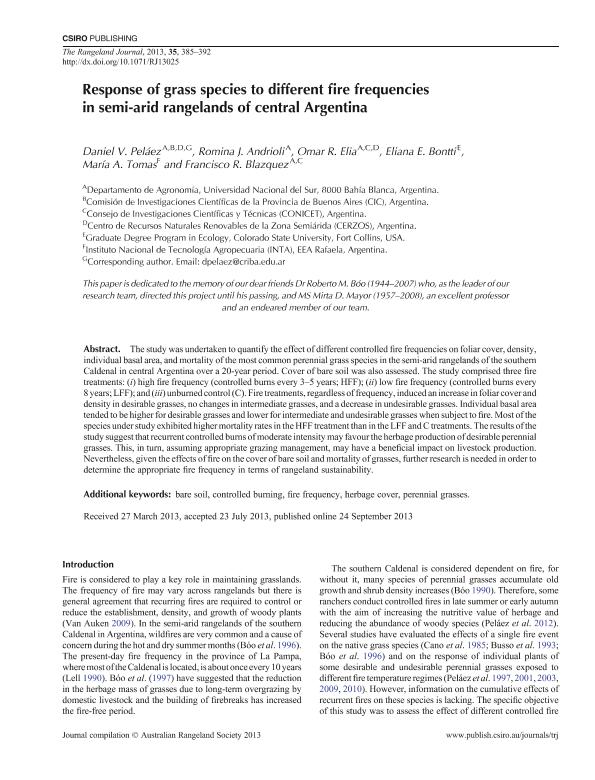Artículo
Response of grass species to different fire frequencies in semi-arid rangelands of central Argentina
Pelaez, Daniel V.; Andrioli, Romina Jessica ; Elia, Omar Raul
; Elia, Omar Raul ; Bontti, Eliana E.; Tomas, María A.; Blazquez, Francisco Ruben
; Bontti, Eliana E.; Tomas, María A.; Blazquez, Francisco Ruben
 ; Elia, Omar Raul
; Elia, Omar Raul ; Bontti, Eliana E.; Tomas, María A.; Blazquez, Francisco Ruben
; Bontti, Eliana E.; Tomas, María A.; Blazquez, Francisco Ruben
Fecha de publicación:
10/2013
Editorial:
Australian Rangeland Society
Revista:
Rangeland Journal
ISSN:
1036-9872
Idioma:
Inglés
Tipo de recurso:
Artículo publicado
Clasificación temática:
Resumen
The study was undertaken to quantify the effect of different controlled fire frequencies on foliar cover, density, individual basal area, and mortality of the most common perennial grass species in the semi-arid rangelands of the southern Caldenal in central Argentina over a 20-year period. Cover of bare soil was also assessed. The study comprised three fire treatments: (i) high fire frequency (controlled burns every 3?5 years; HFF); (ii) low fire frequency (controlled burns every 8 years; LFF); and (iii) unburned control (C). Fire treatments, regardless of frequency, induced an increase in foliar cover and density in desirable grasses, no changes in intermediate grasses, and a decrease in undesirable grasses. Individual basal area tended to be higher for desirable grasses and lower for intermediate and undesirable grasses when subject to fire. Most of the species under study exhibited higher mortality rates in the HFF treatment than in the LFF andCtreatments. The results of the study suggest that recurrent controlled burns of moderate intensity may favour the herbage production of desirable perennial grasses. This, in turn, assuming appropriate grazing management, may have a beneficial impact on livestock production. Nevertheless, given the effects of fire on the cover of bare soil and mortality of grasses, further research is needed in order to determine the appropriate fire frequency in terms of rangeland sustainability.
Palabras clave:
Bare Soil
,
Controlled Burning
,
Fire Frequency
,
Herbage Cover
,
Perennial Grasses
Archivos asociados
Licencia
Identificadores
Colecciones
Articulos(CERZOS)
Articulos de CENTRO REC.NAT.RENOVABLES DE ZONA SEMIARIDA(I)
Articulos de CENTRO REC.NAT.RENOVABLES DE ZONA SEMIARIDA(I)
Citación
Pelaez, Daniel V.; Andrioli, Romina Jessica; Elia, Omar Raul; Bontti, Eliana E.; Tomas, María A.; et al.; Response of grass species to different fire frequencies in semi-arid rangelands of central Argentina; Australian Rangeland Society; Rangeland Journal; 35; 2; 10-2013; 385-392
Compartir
Altmétricas



